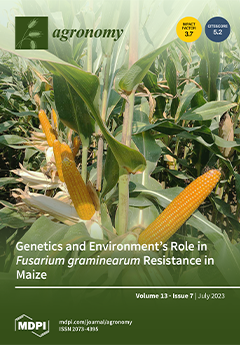Duckweed is a plant with high phytoremediation abilities, which is why it is used in the process of cleaning the aquatic environment. The present study aimed to determine the effect of various concentrations of pig slurry added to the growth media used to produce duckweed (
Lemna minor) (laboratory Warsaw University of Life Sciences—SGGW) (experimental groups 1–9, pig slurry concentration (%): 1—2.00, 2—1.50, 3—1.00, 4—0.75, 5—0.50, 6—0.25, 7—0.12, 8—0.06, 9—0.03, control group 0—0.00). The contents of nutrients in the growth media could be classified as high (gr. 1–3), optimal (gr. 4–6), and deficient (gr. 7–9). Analyses were conducted for duckweed yield and growth medium parameters (pig slurry concentration, pH, salinity, temperature, TDS, and EC) on days 0, 10, 20, and 30 of the experiment. No growth or poor growth of duckweed were noted in groups 1, 6–9, and 0. In turn, satisfactory yields of duckweed green mass were recorded in groups 3–5, which allowed choosing them for further observations and analyses, including proximate composition (including protein content); contents of Ca, Mg, K, Na, Zn, Cu, Cd, Pb, Al, Cr, and α-tocopherol; and carotenoids—β-carotene, α-carotene, violaxanthin, zeaxanthin, lutein, amino acids, fatty acids as well as N-NH
4 and N-NO
3. The plant material had an acceptable proximate composition and nutritionally safe analyzed component contents. Appropriate, stable growth medium conditions allowed the production of satisfactory duckweed yields. The study results allowed us to conclude that it is feasible to obtain feed material meeting basic quality standards by maintaining a closed circuit of duckweed culture, and use in the agricultural environment is possible through harnessing pig slurry for its production and ensuring its optimal growth conditions.
Full article





